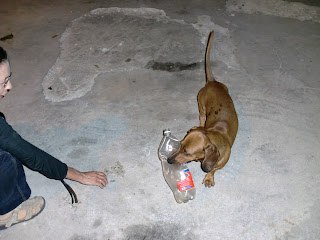Roaming vs Homing
This chapter isn't about a Cuban animal—it's about an
American cat. Before I knew its name, I
thought it was a female because it was small (almost dainty) and soft and sweet
and adorable. A grey and brown short
(although not very short) haired cat with a hint of tiger striping, she looked
the part of a lovable little feline girl.
Steve, my next door neighbor, caught me puttering around the
yard to ask if perhaps we were missing one of our cats. I said no because I knew none of our six ever
leave the house, and, if one ever did get out, it would set off a fusillade of searches,
calls, and emotions beyond imaginable limits.
Telling me this little stranger had been around for a few days, Steve
led me into his front yard and pointed out the little beauty standing in the
bushes near his front door. I crouched
down to call it, and it came right to me without hesitation and asked for some
caresses. Steve isn't a pet person, and
Charlene and I are, so his hope was that we could tell him what to do with the
cat. I mentioned two really good cat
shelters not far away, but I could tell he was hoping we might become involved,
so I said I'd get Charlene to come over and look at it. I thought if she sees it, we'll certainly
become involved.
Sure enough, she saw the lovable little ball of fur and
said, "I'll get a carrier and we'll take it up to Marty." Marty is our vet who runs a large
practice. We've had luck before placing
cats in crates in his waiting room where hundreds of pet lovers pass through
every day. Marty is happy to help out to
get animals adopted out into the local community, and I suppose one more pet
cat in the area can't be bad for business either. Well, come to think of it, we've been the
beneficiaries of Marty's willingness to try to place pets—Marty first showed us
our beloved border collie, Danny, at his office after his former master had
passed away.
The transport duty fell to me, and we put the cat in a
carrier in the front seat of my car. At
the vet office Marty's Chief of Staff, Tawnya, helped me out. I asked her if she would check for a
microchip and told her I'd stick around until I knew if there was one. Fifteen minutes later Tawnya appeared smiling
with the news thee was indeed a chip.
She offered to make calls to the chip maker to identify the owner if I
cared to wait for the results. "Oh
and by the way, this cat's a neutered male," she said.
Meanwhile Charlene had been on the phone to neighboring pet
owners. One had reported another
neighbor's outdoor cat matched the cat's description. Charlene phoned me with what she had learned,
and said she'd called the possible owner (Marjorie, who lived several houses up
the street) and that she had found the owner.
The cat's name was Tom. As I was
hanging up the phone, Tawnya appeared with the owner's name and address and
phone number from the chip maker neatly written on a sheet of note paper, so
Tom and I got back in the car and drove to his house.
Charlene was already in their driveway as I pulled up, and I
set the carrier down in the grass by my car.
Marjorie, while happy to see him back at home was not surprised Tom had
been roaming. "I tried him in the
house, but he likes to scratch the furniture.
Go ahead, let him out of the carrier on the grass" So Tom, unfortunately for him and possibly for
some of the birds in our area, is an outdoor cat. He gets good food, vet care and love, but he
can't come inside with the family.
Seeing how people friendly this cat is, I thought it's a shame he can't
live inside, perhaps only for the lack of a scratching pad or post.
The Humane Society of the US never recommends letting a cat
roam outside—it's bad for the cat and bad for wildlife—lizards, birds,
chipmunks and many other animals. The
cats themselves can get fleas, ticks, and suffer in fights. It's just not good practice.
Sweet little Tom. At
least next time he shows up in Steve's yard, Steve will know he really isn't a
stray, and he's not starving. And the
next time I won't be as tempted to take him into our already large brood.
Les Inglis

































































































